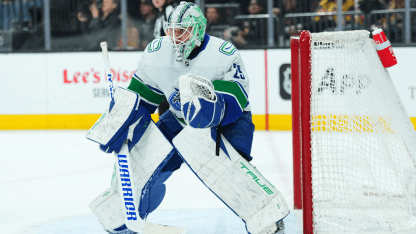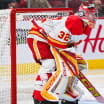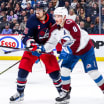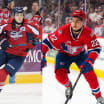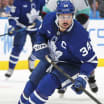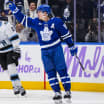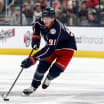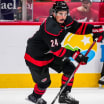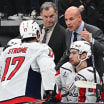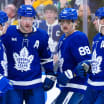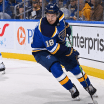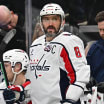One of the great challenges of being a goalie in the NHL is understanding and accepting that trying harder is not always conducive to playing better.
In fact, the opposite is often true.
Much like swinging harder is not usually great advice for a struggling golfer, asking a goalie to try harder during a game is typically a recipe for more problems.
"Goaltending is not an effort-based endeavor," said Casey DeSmith, who is in his sixth NHL season and first with the Vancouver Canucks. "It's not cross-country skiing, or the Tour de France. It's not about trying harder or pushing your limits or anything like that as far as physicality. I would say tension is the enemy."
Tension comes inherently with trying too hard.
"It's the same thing when a player is squeezing their stick, so to speak, but when a goalie is 'squeezing their stick,' our limbs are stiffer. I feel more tense and I feel stiff and as a result, rebounds get away from me. My hands aren't loose, so my hands aren't as good," DeSmith said. "We are staring down the puck, and I'm not taking in the full ice visually, so my reads aren't as good because I'm more puck-focused because you are trying harder, so you are bearing down on the puck."
Tensed muscles react slower, which isn't good when you play arguably the most reactive position in all of sports, said ex-NHL goalie Devan Dubnyk.
It's a lesson Dubnyk learned from his agent, retired NHL goalie Mike Liut, early in his career after a tough game in the American Hockey League. It didn't matter how badly or quickly Dubnyk wanted to bounce back, he couldn't force it.
"Mike told me this is the only position in sports where you can't go out and make things happen. You can't fire yourself up. You can't just try harder because it's one of the only positions in sports that is purely reactive," said Dubnyk, who retired in 2022 after 12 seasons and 542 games in the NHL, and now works as an analyst for NHL Network. "You can't go out and pitch a 50-save shutout if you only get 10 shots. You have to let everything come to you and if you don't and you're pushing forward, and you're trying too hard and you're squeezing, then it just doesn't work. And there's not a lot of positions in sports like that. Really none."
There are several ways trying too hard becomes detrimental to a goalie beyond tensed muscles reacting slower.
There is a tendency to also dig in the skate edges a little deeper and play in a lower, wider stance that further limits lateral mobility and, as DeSmith noted, becomes too focused on the puck.
"If you get in that mindset where a guy is skating down the wall and you want him to shoot that puck so bad, it's all you're thinking about and you're tense and it's like, 'Yeah, shoot this, I'm going to stop it,' and then he makes a pass and you're like, 'Oh no,'" Dubnyk said. "You can get to a point of wanting the puck to you so bad that you're not playing the way you normally play, you're not playing reactive, you're not reading the play. You want the puck to hit you so bad that it's detrimental to the way you play."
Some goalies also tend to get more aggressive positionally when pressing or trying to get out of a slump. That is increasingly problematic as offensive attacks in the NHL focus more and more on creating lateral plays because of the extra distance the goalies then have to travel side to side when playing further out.
"You need intensity still, but you can't go chasing," Dubnyk said. "It's a fine line and once you cross that line and start to chase the play, it's over."
It can become as much a mental battle as a physical one.
As Dubnyk said, you can't make 50 saves if you only get 10 shots, and you can't save them all if you don't stop the first one. Trying too hard or wanting things too bad can also lead to goalies becoming focused on the results and take them away from the "next shot, next save" focus and mentality that so many try to cultivate and maintain.
"It's a difficult mental battle to be a part of," Dubnyk said. "We're all competitive and we all want to win and when things don't go well, the first thing we want to do is go out there and make a difference. A forward can hop the boards and go run somebody, get in a fight and score a goal. We don't get to do that as goalies. We have to do the opposite and rein it in, pull it back and let the game come to us. When you push too hard, you're not letting the game come to you. We all know it's detrimental to how we perform."
It's easier said than done. The same can be true of maintaining a one-shot-at-a-time focus, especially if things aren't going well.
"You couldn't have said that any better," Dallas Stars goalie Jake Oettinger said.
Oettinger credits a return to that next-shot focus for helping turn around a season that wasn't living up to the lofty standards of his first three in the NHL. The Stars No. 1 goalie had an .896 save percentage when he was pulled after giving up four goals on 10 shots against the New Jersey Devils on March 14, but has since won six straight starts with a .955 save percentage and two shutouts allowing a total of seven goals.
"I kind of got away from that approach this year," Oettinger said after making 27 saves in a 3-1 win in Vancouver on March 28. "I was just so focused on trying to do well that I stopped just having fun and playing the game."
